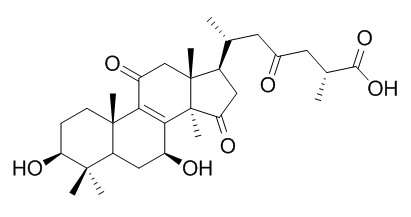Ganoderic acid B
Ganoderic acid B is a chemical marker in quality control of G. lucidum and related products. Ganoderic acid B-containing herbs has potential influence towards therapeutic window of trifluoperazine.Ganoderic acid B has antinociceptive effect; it is moderately active inhibitors against HIV-1 protease with a 50% inhibitory concentration of 0.17-0.23 mM.
Inquire / Order:
manager@chemfaces.com
Technical Inquiries:
service@chemfaces.com
Tel:
+86-27-84237783
Fax:
+86-27-84254680
Address:
1 Building, No. 83, CheCheng Rd., Wuhan Economic and Technological Development Zone, Wuhan, Hubei 430056, PRC
Providing storage is as stated on the product vial and the vial is kept tightly sealed, the product can be stored for up to
24 months(2-8C).
Wherever possible, you should prepare and use solutions on the same day. However, if you need to make up stock solutions in advance, we recommend that you store the solution as aliquots in tightly sealed vials at -20C. Generally, these will be useable for up to two weeks. Before use, and prior to opening the vial we recommend that you allow your product to equilibrate to room temperature for at least 1 hour.
Need more advice on solubility, usage and handling? Please email to: service@chemfaces.com
The packaging of the product may have turned upside down during transportation, resulting in the natural compounds adhering to the neck or cap of the vial. take the vial out of its packaging and gently shake to let the compounds fall to the bottom of the vial. for liquid products, centrifuge at 200-500 RPM to gather the liquid at the bottom of the vial. try to avoid loss or contamination during handling.
University of Guelph2021, 12.
J.Acta Agriculturae Scandinavica2017, 571-575
Molecules.2021, 26(8):2161.
Molecules.2019, 24(12):E2286
Appl. Sci.2020, 10(4),1304
Bioorg Chem.2024, 152:107720.
Mol Neurobiol.2022, 02873-9.
Molecules.2015, 20(11):20014-30
Antioxidants (Basel).2023, 12(2):447.
Gene.2022, 815:146178.
Related and Featured Products
Int J Med Mushrooms . 2018;20(9):859-871.
Triterpenes and Soluble Polysaccharide Changes in Lingzhi or Reishi Medicinal Mushroom, Ganoderma lucidum (Agaricomycetes), During Fruiting Growth[Pubmed:
30317980]
Abstract
We analyzed the changes in triterpenes and soluble polysaccharides in Ganoderma lucidum strain G0119 during 4 growth phases in 3 regions of the fruiting bodies using reversed-phase high-performance liquid chromatography, and we also analyzed the soluble polysaccharides using high-performance size-exclusion chroma-tography-multiple-angle laser-light scattering refractive index analysis. The strong polar triterpenes decreased while weak polar triterpenes increased during the growth cycle of G. lucidum. The highest contents of Ganoderic acid B, ganoderic acid A, and ganoderenic acid B were detected in the stipe during phase II, and ganoderic acid S, ganoderic acid T, and ganoderiol B peaked in the base during phase IV. The total content of soluble polysaccharides in samples decreased after the primordium developed into a fruiting body. Two high-molecular-weight fractions were detected in the soluble polysaccharide samples: α-l,4-glucan and β-l,3-glucan, respectively. They were primarily distributed in the pileus during phase II, and both decreased after this phase. These results led us to select a more suitable growth phase and region for harvesting to obtain extracts with higher contents of triterpenes and soluble polysaccharides.
Biomed Chromatogr. 2013 Sep;27(9):1177-87.
Structural identification of the metabolites of ganoderic acid B from Ganoderma lucidum in rats based on liquid chromatography coupled with electrospray ionization hybrid ion trap and time-of-flight mass spectrometry.[Pubmed:
23723086]
Ganoderic acid B (GAB), a representative triterpenoid in Ganoderma lucidum, possesses various pharmaceutical effects and has been used as a chemical marker in quality control of G. lucidum and related products.
METHODS AND RESULTS:
The metabolites of GAB in vivo after its oral administration to rats were investigated by liquid chromatography coupled with electrospray ionization hybrid ion trap and time-of-flight mass spectrometry. A total of 14 metabolites of GAB in rat plasma, bile and various organs were detected and identified by direct comparison with the authentic compounds and their characteristic mass fragmentation patterns. The results showed that oxidization and hydroxylation were the common metabolic pathways for GAB in rats. Moreover, some reduction metabolites of GAB were detected in rat kidney and stomach and glucuronidation only appeared in rat bile.
CONCLUSIONS:
This is the first report on the metabolites of GAB in vivo.
Afr Health Sci. 2015 Mar;15(1):146-9.
Ganoderic acid B's influence towards the therapeutic window of trifluoperazine (TFP).[Pubmed:
25834543]
Ganoderic acid B is an important bioactive ingredient isolated from Ganoderma lucidum, and exhibits various pharmacological activities.
To investigate the influence of Ganoderic acid B towards the therapeutic window of trifluoperazine (TFP).
METHODS AND RESULTS:
In vitro human liver microsomes (HLMs) incubation system was used to determine the inhibition of Ganoderic acid B towards the glucuronidation of trifluoperazine (TFP).
Ganoderic acid B exerted concentration-dependent inhibition towards the glucuronidation of TFP. Furthermore, Dixon plot was used to determine the inhibition type. The intersection point was located in the second quadrant in Dixon plot, indicating the competitive inhibition of Ganoderic acid B towards TFP glucuronidation. Through fitting the data using competitive nonlinear fitting equation, the inhibition kinetic parameter was calculated to be 56.7 uM.
CONCLUSIONS:
All this data indicated the potential influence of Ganoderic acid B-containing herbs towards therapeutic window of TFP. Given that the glucuronidation reaction of TFP is the probe reaction of UGT1A4, the data obtained from the present study also indicated the potential influence of Ganoderic acid-containing herbs towards the therapeutic window of drugs mainly undergoing UGT1A4-mediated metabolism.



